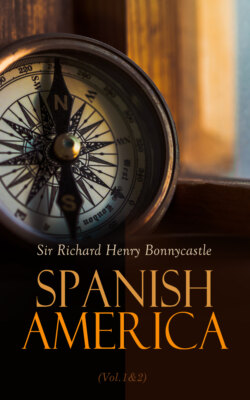Читать книгу Spanish America (Vol.1&2) - Sir Richard Henry Bonnycastle - Страница 23
На сайте Литреса книга снята с продажи.
SINALOA OR CINALOA.
ОглавлениеSinaloa is the most southern province which is comprehended under the intendancy of Sonora; it is bounded by the gulf of California on the west, on the east by New Biscay, or the ridge or Cordillera of Topia, also called Tepecouan, and Sierra Madre, on the north by Mayo, and on the south by Culiacan. This country is about 300 miles in length from the south-east to the north-east, and 120 miles broad.
Sinaloa was discovered by Nunez de Guzman in the year 1552. The climate is good, the air being very pure, the land fertile, and producing abundantly grain, cotton, and fruits.
The rivers are numerous, though small, and well stored with fish.
Sinaloa is chiefly inhabited by Indians, though there are numbers of mining stations established; and the province bids very fair to be well colonized. The natives are a warlike race, and were with great difficulty brought to submit to the dominion of the Spaniards. They have caciques or chiefs, whose authority is however very limited, being confined to heading warlike expeditions. It is chiefly by valour displayed in battle, or hunting, that they obtain this distinction; sometimes indeed the interest of a powerful family elevates one of their number to the caciqueship. They are fond of oratory, and if one of their number displays any great ability in this art, universal acclamations decree him their chieftain. These latter instances are however rare. Laws are unknown.
Their weapons are bows, with poisoned arrows, heavy clubs of wood and shields. These people are more industrious than their Californian neighbours in manufacturing coarse cotton stuffs. Many of the tribes subsist entirely by hunting and fishing, and have no regular residences, neither do they till the ground. In the inland parts these tribes are chiefly found subsisting by the chase; on the sea coast they live by their industry, and by the fishery.
Those in the mountainous regions are reckoned to be in the most perfect state of nature of any of the American Indians, relying solely on their skill in the chase, and on the bounty of nature in her produce of roots, fruits, and plants. During the rainy season, they make a large cap of rushes like a pent-house or umbrella, which they wear on their heads to throw off the water, by which means they keep themselves dry for a considerable time. They construct a sort of rude wigwam of branches, to shield themselves from the scorching rays of the summer sun, and in winter they constantly keep large fires, round which they sleep, eat, and drink, with no other canopy than Heaven. The heat in this country exceeds the cold, and they have little other bad weather, than during the rainy months.
There are many gold and silver mines in the mountainous parts of this district, and in one of these called Yecorato, there was found a piece of gold which weighed 16 marks and upwards, the mark being two-thirds of a pound, or eight ounces. This was sent to Spain and deposited in the royal cabinet of Madrid. The chief mining station is Sivirijoa.
The principal town is Cinaloa, or St. Felipey St. Jago, on the river Cinaloa, in 106° west longitude, and 26° north latitude, 630 miles north-west of Mexico; the stream on which it stands and the Rio del Puerto, form the two principal rivers of this province; they both rise in the Cordillera of Topia, and receiving other streams in their course, enter the southern part of the Californian sea, very near each other, and a little to the northward of Macapule Bay. Cinaloa contains 9500 inhabitants.
The chief place of the whole government of Sonora is the capital.
Arispe, which has the forts of Bacuachi and Bavispe on the south and west.
Hostimuri, the chief place of Mayo and Hiaqui, has many rich mines in its vicinity, with a council of the mines situated at St. Xavier.
Los Alamos is also another station of note for the mines, between the Mayo and Fuerte rivers, with a population of 7900.
The towns of Sonora Proper, and Ostimuri, are three in number, the villages 46, and the missions 46; of these villages, many are mining stations.
Cinaloa contains four towns, Cinaloa, Montes Claros, with 7900 souls; and El Rosario 5600; with 92 villages, numerous distinct farms and missions, and many important mining stations.
